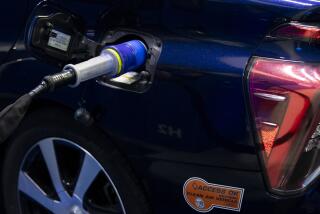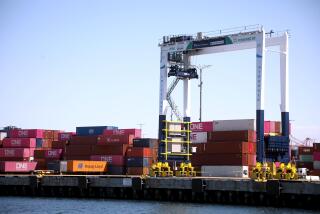2 Suspect Labs Could Have Produced Hydrogen
- Share via
WASHINGTON — In concluding that two trailers seized in northern Iraq were biological weapons labs, the United States rejected Iraqi claims that the vehicles were designed for making hydrogen for weather balloons.
But although some have described the Iraqi explanation as far-fetched, the U.S. Army has its own fleet of vehicles designed for precisely the same purpose.
They are among the Army’s more unusual vehicles: Humvees with a large container and refrigerator-sized generator where a gun or troop transport shell should be.
The AN/TMQ-42 Hydrogen Generator, as it is known, has never been used in combat. With plenty of helium -- the preferred gas -- to keep the Army’s weather balloons aloft, it’s unlikely that it ever will.
But the truck escapes obscurity in becoming a footnote to the debate over Iraq’s alleged chemical and biological weapons programs.
The CIA and the Pentagon’s Defense Intelligence Agency have described the two seized trailers as “the strongest evidence to date that Iraq was hiding a biological warfare program.” But some analysts involved in the examination of the vehicles reject that conclusion. And that inspection has failed to find any traces of anthrax, smallpox, tularemia or any other known pathogens.
One veteran intelligence official in Iraq said he is convinced that the seized trailers were indeed designed to produce hydrogen gas to fill weather balloons that were routinely used by Iraqi field artillery batteries.
The intelligence official, who spoke on condition of anonymity, said the trucks did not carry autoclaves or other equipment needed to sterilize laboratory equipment, as would be needed to grow sensitive pathogens used as germ agents.
In addition, he said, the canvas tarps covering the sides of the trucks appeared designed to be pulled away to let excess heat and gas escape during the production of hydrogen. The tarps would allow in far too much road dust and other contamination if the equipment inside were meant to produce biowarfare agents, he said.
“We didn’t find what we expected to find,” said the official, who was involved in the investigation. “That’s very troubling.”
Weather balloons are used by artillery units to collect atmospheric measurements -- including wind speed and relative humidity -- that help calculate the trajectory of rockets and cannon fire.
The London Observer recently reported that the British government sold an artillery weather balloon system to Iraq in the late 1980s.
U.S. artillery units generally fill their balloons with helium, a less combustible -- and therefore much safer -- gas than hydrogen. But experts said Iraq probably wouldn’t have access to helium, a naturally occurring gas that is scarce in most parts of the world. In fact, the vast majority of the world’s supply happens to be in Texas.
Faced with that problem, Iraq wouldn’t be the first country to turn to hydrogen, which can be manufactured from other substances.
In the 1930s, the United States refused to share its helium supply with Germany for fear that Hitler would use it in military airships. So the Germans used hydrogen instead, including in passenger airships.
The risk of doing so was demonstrated in devastating fashion in 1937 when the airship Hindenburg, after a transatlantic journey, erupted in flames over Lakehurst, N.J.
In their publicly released analysis of the two Iraqi trailers, the CIA and DIA acknowledged that the vehicles could be used to produce hydrogen but dismissed that capability as a convenient cover story.
The CIA noted that Iraq never declared the vehicles to United Nations inspectors, something they would have faced no risk in doing if they were truly for hydrogen production. CIA officials also said the design of the trailers was unnecessarily elaborate and cumbersome for hydrogen production.
“If they wanted to produce hydrogen, they could have produced it more efficiently,” said one CIA official, who noted that smaller, safer, portable systems are commercially available.
Even so, the agencies’ report noted that Iraqi officials at the Al Kindi research facility in Mosul, as well as Iraqis interviewed at a company that manufactured components for the vehicles, all said the trailers were built to make hydrogen.
The two trailers have been under armed guard at Camp Slayer, a former Iraqi government palace and amusement complex near the Baghdad airport now serving as a logistics and operations base for U.S. intelligence and weapons-hunting teams.
The U.S. hydrogen trucks aren’t likely to see action any time soon, either. One is collecting dust at Ft. Sill, Okla., where Army and Marine artillery units are trained. Asked the whereabouts of the other 19 trucks, Army officials could say only that they believe the trucks are mothballed in a depot somewhere.
The Army ordered the trucks thinking they might come in handy if artillery units were deployed somewhere where helium couldn’t be delivered.
Some saw other advantages. Although helium is more stable than hydrogen, it is still risky to transport in canisters when bullets are flying. Unlike helium, hydrogen can be manufactured on the spot, with no need to store it or ship it across dangerous terrain.
The Army hired a Baltimore company called Environmental Technologies Group to build the vehicles, and the first unit was equipped in 1998. Environmental Technologies has since been acquired by U.K.-based Smiths Group.
Rick Thomas, an executive at the company in Maryland, said the system works by combining methanol and water in a generator that yields carbon dioxide and pure hydrogen gas. The system, he said, performed well and was designed to hold up under rugged Army conditions.
But the use of methanol as an ingredient was the system’s undoing, Thomas said. Army safety and environmental experts barred the use of the vehicles because methanol is an environmental contaminant.
Thomas and other executives at the company were quick to say that their truck -- unlike Iraq’s version -- could only be used to produce hydrogen. They declined to disclose the dollar amount of the contract.
Asked whether company officials were disappointed that the trucks have never been used, he said, “That is an understatement.”
*
Times staff writer Bob Drogin in Baghdad contributed to this report.
More to Read
Sign up for Essential California
The most important California stories and recommendations in your inbox every morning.
You may occasionally receive promotional content from the Los Angeles Times.










